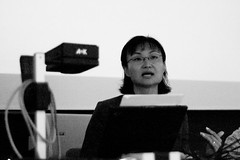New Network Theory – Review
For three executive sunny days last week, the humanity studies faculty of the University of Amsterdam hosted the New Network Theory conference. This four party collaborative initiative – consisting of Amsterdam School of Cultural Analysis, Institute of Network cultures, University of Amsterdam, and the Hogeschool van Amsterdam – was to exploit the potential of formulating a post-Castellsian network theory which “takes technical media seriously”. Social Software and developments in technical media have influenced the Web, now is the time to document what exactly changed and formulate an up-to-date paradigm.
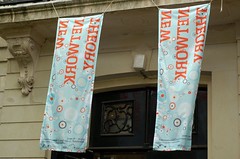 As I entered UVA grounds my eyes fell upon the two polyester banners waving above the entrance. Besides the name of the conference the banner contained a well designed background which seemed to resemble a gearing mechanism. In Dutch the word ‘raderwerk’ could describe the red, black and green mechanical wheels. ‘Raderwerk’ can be interpreted as “samengesteld geheel van menselijke organisatie” which in English translates into “compiled sum total of human organization”.
As I entered UVA grounds my eyes fell upon the two polyester banners waving above the entrance. Besides the name of the conference the banner contained a well designed background which seemed to resemble a gearing mechanism. In Dutch the word ‘raderwerk’ could describe the red, black and green mechanical wheels. ‘Raderwerk’ can be interpreted as “samengesteld geheel van menselijke organisatie” which in English translates into “compiled sum total of human organization”.
More artwork – a selection from the Places & Spaces: mapping science exhibition – decorated the conference hall.
After the essential coffee in the lobby Geert Lovink, Richard Rogers and Jan Simons officially opened a discussion that would take three days and two dinners. After some formalities Jan 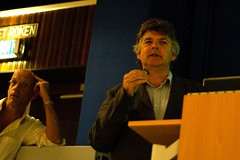 told an amusing, yet serious, anecdote of how a mere one and a half decade ago the University was linked to the outside world using one computer and a dial-up modem. The connected computer – set up by a former student – was the only place where teachers and staff members could email and browse the web, its location consequently developed into a sort of social gathering spot and perhaps in a sense a physical network surrounded this virtual interest. Thomas Elseasner spiced up the faculty with laser discs and multi media technologies; a department was born. After several name changes, nowadays Media Studies forms the largest part of the faculty of Humanities, and New Media – next to Journalism, Television Studies and Film Studies – is an independent research area.
told an amusing, yet serious, anecdote of how a mere one and a half decade ago the University was linked to the outside world using one computer and a dial-up modem. The connected computer – set up by a former student – was the only place where teachers and staff members could email and browse the web, its location consequently developed into a sort of social gathering spot and perhaps in a sense a physical network surrounded this virtual interest. Thomas Elseasner spiced up the faculty with laser discs and multi media technologies; a department was born. After several name changes, nowadays Media Studies forms the largest part of the faculty of Humanities, and New Media – next to Journalism, Television Studies and Film Studies – is an independent research area.
The opening session involved à la mode themes: Google, security, and imagined networks; yet, the discussions were cerebral and insightful. Siva Vaidhyanathan – introduced by Richard as “you might know him from the Demetri Martin sketch shown on the Daily Show” – put forward a bold question: “what does Google give us besides ads in small fonts?” Google is googlizing everything, it is one company that directly influences culture, commerce and community. Paradoxically, whilst copying websites (in order to index), making editorial decisions in searc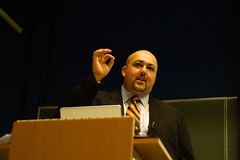 h results, recording user traffic, and storing generated user profiles, Google offers the illusion of democracy, precision and objectivity. We pay for Google with our data and allow Google to taylor personalized advertments. In fact we are enthused and voluntary willing – and this is different in a disciplinary society, as suggested by Michel Foucault – to provide personal data, as well as accept privacy intrusion. Siva makes reference to disciplinary power as exemplified by Bentham’s Panopticon, a building that shows how individuals can be supervised and controlled efficiently. Institutions modeled on the panopticon have spread throughout society. Foucault exemplified this with the prison, which develops from this idea of discipline as it aims both to deprive the individual of his freedom and to reform him. The prison is part of a network of power that spreads throughout society, and which is controlled by the rules of strategy alone. Calls for its abolition fail to recognize the depth at which it is embedded in modern society, or its real function. However, Siva calls for a renewed approach to understanding this kind of consumer surveillance, one that pushes aside the worn-out model of the panopticon.
h results, recording user traffic, and storing generated user profiles, Google offers the illusion of democracy, precision and objectivity. We pay for Google with our data and allow Google to taylor personalized advertments. In fact we are enthused and voluntary willing – and this is different in a disciplinary society, as suggested by Michel Foucault – to provide personal data, as well as accept privacy intrusion. Siva makes reference to disciplinary power as exemplified by Bentham’s Panopticon, a building that shows how individuals can be supervised and controlled efficiently. Institutions modeled on the panopticon have spread throughout society. Foucault exemplified this with the prison, which develops from this idea of discipline as it aims both to deprive the individual of his freedom and to reform him. The prison is part of a network of power that spreads throughout society, and which is controlled by the rules of strategy alone. Calls for its abolition fail to recognize the depth at which it is embedded in modern society, or its real function. However, Siva calls for a renewed approach to understanding this kind of consumer surveillance, one that pushes aside the worn-out model of the panopticon.
This brings me to on an idea loosely sketched out by Gilles Deleuze towards the end of his life, which suggests that in the Twentieth century we have moved from a disciplinary society to a more invasive society of control (Deleuze, 1995). This does not mean that disciplinary institutions have disappeared, but that their authority is no longer confined to particular institutions. Instead power is becoming integrated into every aspect of social life by increasingly interconnected networks.
In Control and Freedom: Power and Paranoia in the Age of Fiber Optics Wendy Chun draws on the theories of Deleuze and Foucault and argues that the relationship between control and freedom in networked contact is experienced and negotiated through sexuality and race. In her book Wendy makes use of an elaborate analysis of phenomena as Webcams and face-recognition technology to explore the current political and technological coupling of freedom with control.
However, Wendy’s presentation did not regard power and paranoia in the age of fiber optics; nonetheless, freedom and control are fundamental concerns also in Wendy’s discussion of imagined networks, Facebook, and ‘Free software movement vs. Open software movement’. Drawing from Benedict Anderson’s analysis of the nation as an “imagined community,” Wendy argues that we are witnessing the emergence of make imagined groupings -imagined networks – that are both less and more than communities or nations. In doing so, she does not argue for the distributed network as the model for our social interactions, bureaucratic organizations, or even our technologies, but rather asks: what needs to be in place for us to understand ourselves and our technologies as networked? How do social and technological abstractions coincide, diverge and inform each other? and how are these abstractions experienced, sensed, felt?
Wendy’s discussion touched upon three focus areas; firstly the privitations of openness, the seductions and limitations of mapping, and thirdly the temporality of networks – referring to speed versus the enduring ephemeral. Wendy describes networks as the structure and content of society and ultimately that of culture too. Network culture can be defined as “diagrammatic representation of interconnected events, processes etc. used in the planning of complex projects or sequences”.
When looking at social networks such as the immensely popular Facebook (when people in the audience with a Facebook account were asked to raise their hands, five – maybe six – people responded) contemporary network culture can be fleshed out. Facebook is a gated community; it is a network consisting of ones friends and friends of friends. Therefore Facebook is not a public space; there are private enclosures in its public spaces. Anonymity is not a big factor in Facebook and social networks alike; gender, race, religion, sexual preference, status make itself present. The much discussed utopian myth of cyberspace being a virtual place liberated from actual identity seems to shift to one which reflects the physical world. Obviously this technology and its content lend itself to matters such as public scrutiny and surveillance. On the other hand the network content is restricted to ones imagined community. Furthermore users seem to find ‘belonging’ more important than the content itself.
The underlying nature of network in the end is code. Consequently to know the code, is to know the building blocks of “the new agora” and how this space is connected to its physical resemblance. Open space and public space are not the same, consequently the free software movement and the open software movement are not synonymous, however one might ask what is the difference? Wendy, who is currently involved in an initiative called “open source imagined networks” asserts the difference lies in the network that is imagined. The new agora is not a place it is an assembly. The best way to view the network is to reject the map. So in the end it is not software which frames us, the public is a network and we are all nodes in it, social communities are mere private enclosures, so a valid question would be: how do we think beyond the map, or how do we think beyond the link? Which bring me to Warren Sack who discussed the transition from network publics to object oriented democracies.
 Warren started his talk with an example of how publics get framed. Public opinion was framed within ten minutes when Bush put forward the act of war. Framing is an important subject and when analyzed from a historical perspective provides a greater understanding of ourselve and as nodes in a network. In order to analyze public as a network, Warren raises the question “how has the public been framed?” and proposes a new definition, that being an ‘object oriented democratic public’. Firstly Warren describes the public metaphorically, and then defines the public building forth on work by Dewey (1927) who characterized the public as state, and finally poses answers on how new technologies of representation can facilitate more democratic publics with richer measures, modes of visualization, and structures of participation.
Warren started his talk with an example of how publics get framed. Public opinion was framed within ten minutes when Bush put forward the act of war. Framing is an important subject and when analyzed from a historical perspective provides a greater understanding of ourselve and as nodes in a network. In order to analyze public as a network, Warren raises the question “how has the public been framed?” and proposes a new definition, that being an ‘object oriented democratic public’. Firstly Warren describes the public metaphorically, and then defines the public building forth on work by Dewey (1927) who characterized the public as state, and finally poses answers on how new technologies of representation can facilitate more democratic publics with richer measures, modes of visualization, and structures of participation.
Firstly Warren depicts the public metaphorically; initially as a physical system or mass, secondly a thermodynamic system, thirdly as an ecology in the sense that publics struggle for territory and cause interactions, fourthly as an organism – similar to a notion of McLuhan explaining the railroad as a new animal with new technology, and lastly as a network.
Warren then turns to Noortje Marres (2005) who has sought to address current representational shortcomings by offering a new metaphor – “object-oriented democratic politics”. The new metaphor is an effort to engage not only the subjects of politics, being the people that constitute a public, but also the objects of concern or contention, such as the issues that motivate a public’s organization. What would the software of an object orientated democratic public look like? Warren names two examples TXTmob (coordinate movement plus text messaging during demonstrations) and Metavid– comment at any moment in these debates.
Object-oriented programming, Warren continues, was invented more than 40 years ago and incorporates both a means for describing structures and processes. The definition of an “object” incorporates both a description of its structure and a definition of associated processes (usually called “methods” or “handlers”) that might be used to query or change the structure. For example, graphical computer interfaces are usually programmed using object-oriented methods. The interface’s structures—its buttons, windows, menus, and their arrangement—are defined as objects and then handlers are added to the objects to define what should happen if, for example, a user pushes a button or clicks the mouse on an item of a menu. “Object-oriented publics” improves upon the network metaphor insofar as it both incorporates a means for describing processes—the dynamics and changes that can occur over time—and a framework for retaining distinctions between opposing entities. It enables us to ask a new set of questions about publics and their actions. Soon, perhaps, it will be quite dated to imagine oneself as a node in a social network of Friendsters. Maybe, following the language of computer science, we will soon understand ourselves as “object handlers.”
The second day of the conference was formatted differently; instead of having the sessions in one hall, the talks were divided according to theme and spread across the vicinity. The conference booklet – containing a timetable, speaker background, and room numbers – turned into a sort of menu card, allowing you to shop for knowledge. I ordered a plenary session of Locative Media.
Nowadays everything in the media world gets tracked, tagged and mapped. Cell phones become location-aware, computer games move outside, the web is tagged with geospatial information, and geobrowsers like Google Earth are thought of as an entirely new genre of media. Spatial representations have been inflected by electronic technologies (radar, sonar, GPS, WLAN, Bluetooth, RFID etc.) traditionally used in mapping, navigation, wayfinding, or location and proximity sensing. We are seeing the rise of a new generation that is “location-aware”. This generation is becoming familiar with the fact that wherever we are on the planet corresponds with a latitude/longitude coordinate.
The term “Locative Media”, initially coined in 2003 by Karlis Kalnins, seems to be appropriate for digital media applying to real places, communication media bound to a location and thus triggering real social interactions. Locative Media works on locations and yet many of its applications are still location- independent in a technical sense. As in the case of digital media, where the medium itself is not digital but the content is digital, in Locative Media the medium itself might not be location-oriented, whereas the content is location-oriented. Thus wireless and mobile media have re-introduced questions of space and place. Cyberspace and the so-called ‘real world’ converge into what Lev Manovich called ‘augmented reality’, and in this ‘augmented reality’ it does not matter where you are. On the other hand, the technology lends itself to surveillance and control, thus in the end it might be important where you are? The network in most instances might be invisible but can you remain out of sight?
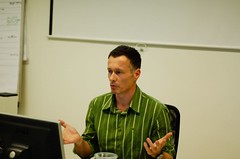 Adrian Mackenzie begins the session on Locative Media dealing with his paper on “wirelessness and radical network empiricism”. In some ways, Adrian Mackenzie states, wireless networks are very unpromising candidates for network theory. In contrast to the high-profile social software-based networking and organized network debates, they are quite banal, and they are often relatively invisible. They are certainly not the main hotspot of practices or changes associated with new media or technological cultures. However, wireless networks, despite being mundane, persistently associate themselves into the centre of media change in very diverse zones of the social. These include the areas of convergence between different infrastructures and places, (telephone, transport, domestic, commercial, etc), the intersections between ICT and development (ICT4D), the sheer proliferation of mobile gadgets, and last but not least, the question of networks and the body, in the case, in the form of altered bodily comportments, and fears around radiation. Across all of these areas, wireless networks merit interest because they epitomize very rapid transitions.
Adrian Mackenzie begins the session on Locative Media dealing with his paper on “wirelessness and radical network empiricism”. In some ways, Adrian Mackenzie states, wireless networks are very unpromising candidates for network theory. In contrast to the high-profile social software-based networking and organized network debates, they are quite banal, and they are often relatively invisible. They are certainly not the main hotspot of practices or changes associated with new media or technological cultures. However, wireless networks, despite being mundane, persistently associate themselves into the centre of media change in very diverse zones of the social. These include the areas of convergence between different infrastructures and places, (telephone, transport, domestic, commercial, etc), the intersections between ICT and development (ICT4D), the sheer proliferation of mobile gadgets, and last but not least, the question of networks and the body, in the case, in the form of altered bodily comportments, and fears around radiation. Across all of these areas, wireless networks merit interest because they epitomize very rapid transitions.
In conclusion Adrian has talked about radical network empiricism in order to make sense of the dynamism of wireless networks. It is not a complete network theory; instead Adrian’s discussion intended to say something about the kind of collective energies that animates wireless networks. What comes of putting together the antennae-focused algorithmic flows, the overflows of market-citizen, and the inconceivably rapid transitions associated with development? Wirelessness does not belong to any individual subject. It includes things, feelings, and images. It does not form a proper object of analysis, at least in a normal sense.
This is where James’ radical empiricism comes in. ‘Relations between experiences’ must be counted as just as real as the things experienced. This seems eminently well-suited to thinking about networks. The key support to analysis that James’ radical empiricism offers concerns how to give primacy to relations without presuming too much about what comes into relation, without saying too much about who or what experiences it. If we say that experience is a member of diverse processes, then immediately it suggests that our experience is not easily reducible to us, to the forms of agency and identity we can think. Instead, we have to think of that experience as a situation, as an ongoing temporal-spatial process, that overflows, that streams, that ‘falls forward’.
Locative Media open up new possibilities for users to engage socially and co-create texts. Currently there are perhaps as many maps as there are mapmakers, cell phones facilitate new forms of broadcasting and file sharing, and Bluetooth technology allows people to produce new-fangled interactions.  Sophia Drakopoulou build forward from these notions and discussed the existence of a virtual space of data share and exchange which has the potential to be used as an environment for individual broadcast. Central in her research are two recent phenomena that have appear in the media: the worldwide hoax of ‘Toothing’ and the London phenomenon of ‘Happy Slapping’. ‘Happy Slapping’ has been inflamed by the media. This violent juvenile act involves unaware people being smacked whilst filmed by a mobile phone camera. The video is then widely distributed amongst the teens. The ‘toothing’ phenomenon was reported the media. The Guardian, Reuters and Wired magazine published articles last year about a new British trend called ‘Toothing’. This involved mobile phone users enabling their Bluetooth devices on the London Underground, to find strangers for casual sex encounters, on a station’s lavatories. A web forum was set up where ‘Toothers’ shared their experiences. This turned out to be a hoax. Sophia is asking why the Media always fantasizes about new technologies with sex and violence.
Sophia Drakopoulou build forward from these notions and discussed the existence of a virtual space of data share and exchange which has the potential to be used as an environment for individual broadcast. Central in her research are two recent phenomena that have appear in the media: the worldwide hoax of ‘Toothing’ and the London phenomenon of ‘Happy Slapping’. ‘Happy Slapping’ has been inflamed by the media. This violent juvenile act involves unaware people being smacked whilst filmed by a mobile phone camera. The video is then widely distributed amongst the teens. The ‘toothing’ phenomenon was reported the media. The Guardian, Reuters and Wired magazine published articles last year about a new British trend called ‘Toothing’. This involved mobile phone users enabling their Bluetooth devices on the London Underground, to find strangers for casual sex encounters, on a station’s lavatories. A web forum was set up where ‘Toothers’ shared their experiences. This turned out to be a hoax. Sophia is asking why the Media always fantasizes about new technologies with sex and violence.
This is interesting in the context of current events in the Dutch Media regarding photo/video sharing activities in schools, leading to a request put forward by MP Arda Gerkens from the SP (Dutch party, currently in the opposition) to forbid cell phones in schools. The photographs and videos are pornographic in nature, they consist of pictures/videos taken by students of (naked) colleague students, or pornographic material downloaded from the internet and uploaded to the cell phone. The SP is arguing that pictures and videos of students spread via cell phones is a new form of a pedophilic network. Although not discussed by Sophia last week, it relates to the context discussed by Sophia; similar to the happy slapping videos teenagers think about narrative, they frame and direct a video, they create their own media. In bluetoothing nicknames (with a sexual connotation) express a desire to break from social conventions. These two phenomena of the use of the space of data share and exchange manifest an ataxia a break from the social order, via a projected ‘tele-deviance’.
It is interesting to see how new media technologies such as the cell phone facilitate new practices or remediates old ones. The cell phone distinguishes itself from other media in the sense that it converges many media in one device, one that is portable and familiar. The cell phone is, similar to the Sony Walkman as discussed by du Gay et al, a cultural artifact shaped by large, commercial, transnational enterprises, as well as the articulation of a number of distinct processes whose interaction has lead to a variable and contingent outcome; interlinked processes like representation, identity, production, consumption, and regulation.
Which brings me to actor-network theory, which tries to explain how material-semiotic networks come together to act as a whole.
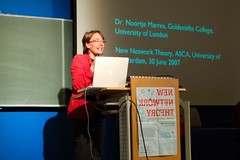 On the last day the closing session concerned actor-network theory. Noortje Marres discussed the network addressed from the home, more precisely, the eco home as a site of network entanglements. Noortje says wind energy and other alternative energy plus decentralization of energy economy will assist a grass-rooted form of democracy, a ‘do it yourself citizenship’. Following Saskia Sassen, Noortje states the decentralization of energy infrastructure leads to democratization. By using the eco home as the center of a network critique, her talk touches upon John Dewey, machines of (dis)affectedness, and how the home shifts from a defense/shelter to a public place with collective practices (such as collective laundry).
On the last day the closing session concerned actor-network theory. Noortje Marres discussed the network addressed from the home, more precisely, the eco home as a site of network entanglements. Noortje says wind energy and other alternative energy plus decentralization of energy economy will assist a grass-rooted form of democracy, a ‘do it yourself citizenship’. Following Saskia Sassen, Noortje states the decentralization of energy infrastructure leads to democratization. By using the eco home as the center of a network critique, her talk touches upon John Dewey, machines of (dis)affectedness, and how the home shifts from a defense/shelter to a public place with collective practices (such as collective laundry).
At the end of the day there was time for feedback and criticism. Alan Liu asked why the organizers had chosen the applied, rather academic format, and not a more open ad-hoc arrangement. Geert replied that in order to get sufficient funding the conference had to have an academic set-up. Moreover, the organizers were told the conference lacked in academic quality/arrangement and was neglected full funding. The initial venue was much nicer and offered more possibilities for tentative conference formats. Richard added that the suggested open arrangement, where unplanned speakers spontaneously write their name on a board at the moment they like the topic being discussed, usually get held in the woods or at a camping site. Richard has been to few of these camp out events (what the hack) where “you get to know one another in ways you normally would not imagine”. Nonetheless, a set-up step up is necessary. Richard mentioned a suggestion made by Michael Stevenson to have speakers SMS their abstracts, within 160 characters, prior to their presentation.
